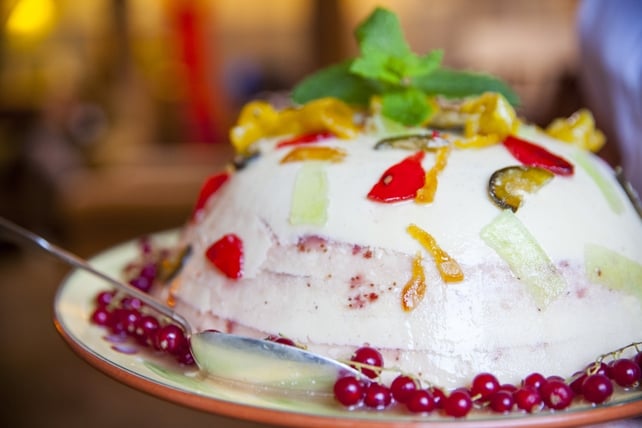Tune into Lords & Ladles on RTÉ One this Sunday at 6:30pm for some fantastic vintage recipes. Check out a selection of first and second courses plus dessert recipes from Hilton Park, Scotshouse, Co Monaghan.
See how the other half lived in this original and unique TV food show where you can see on this week's programme what was on the menu in Hilton Park, Scotshouse, Co Monaghan. Diner du Mercredi le 24 Novembre 1880.
Potage
White Soup a la Reine
Truss a fowl; put it on the spit and set it down before the fire to roast; and while the fowl is roasting, wash three-quarters of a pound of rice, and boil it very gently in three pints of white veal stock for about an hour.
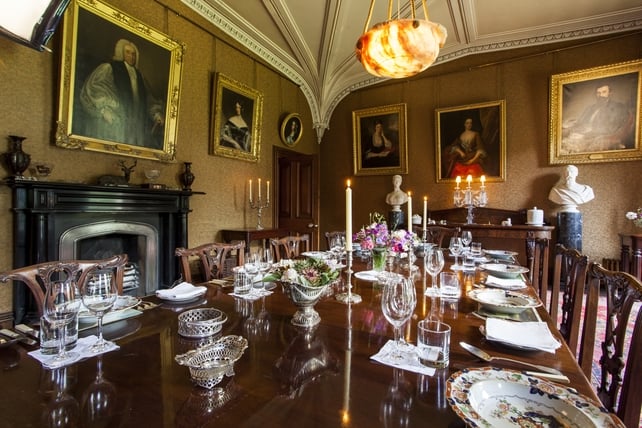
Remove all the meat from the fowl; chop and pound this in a mortar, with an ounce of butter and a gill of broth; and when it is thoroughly reduced to a smooth pulp, add the rice; pound all together; take this up into a stewpan, moisten with a quart of broth (made with the bones of the fowl and a pound of veal, with carrot, celery and onion); rub the purée through a tammy, and when this is done, pour the soup into a small soup-pot; stir it over the fire until hot, season with a little pepper and salt, mix in half a pint of cream, and serve with friend crusts on the surface of the soup.
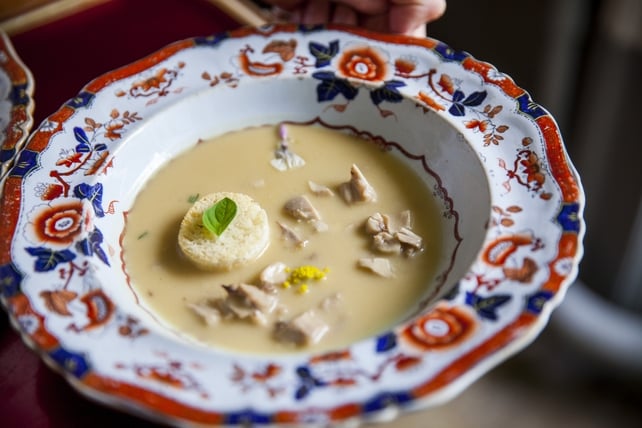
Poisson
Fillets of Turbot à la Ravigotte
Cut a small turbot into neatly trimmed fillets or scallops, place them in a sauté pan with some fresh butter, season with pepper and salt, and lemon-juice; ten minutes before dinner set them on a moderate fire, and when sufficiently simmered on one side, turn them carefully on the other, so as not to break them; when done, drain the fillets on a napkin, and dish them up, overlaying each other – so as to form a close circle; sauce them with some white Ravigotte sauce and send to table.
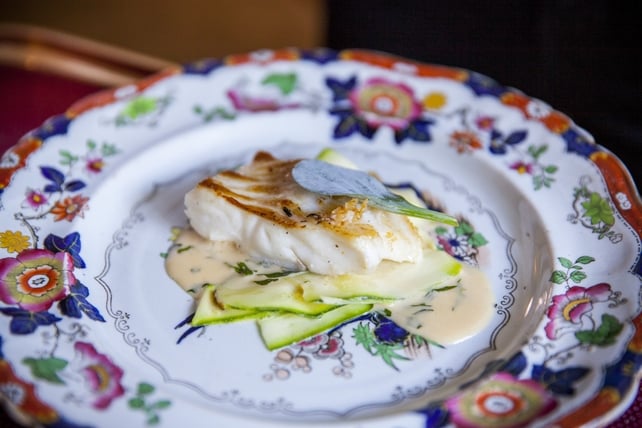
White Ravigotte Sauce
Put into a small stewpan two tablespoonfuls of Chili vinegar, the same quantities of Tarragon-vinegar and of Harvey sauce; reduce these by boiling to half the quantity; then add a small ladleful of good Béchamel sauce or, if not at hand, the same quantity of white sauce; finish by mixing in two pats of fresh butter and just before using the sauce, throw in a tablespoonful of chopped and blanched parsley. When white sauce is used instead of Béchamel, a little cream must be added.
Harvey Sauce
Chop twelve anchovies, bones and all, very small, with one ounce of cayenne pepper, six spoonfuls of soy, six ditto of good walnut pickle, three heads of garlic chopped not very small, a quarter of an ounce of cochineal, two heads of shalots chopped rather large, one gallon of vinegar; let it stand fourteen days, stir it well twice or thrice every day, then pass it through a jelly bag, and repeat this till it is quite clear; then bottle it, and tie a bladder over the cork.
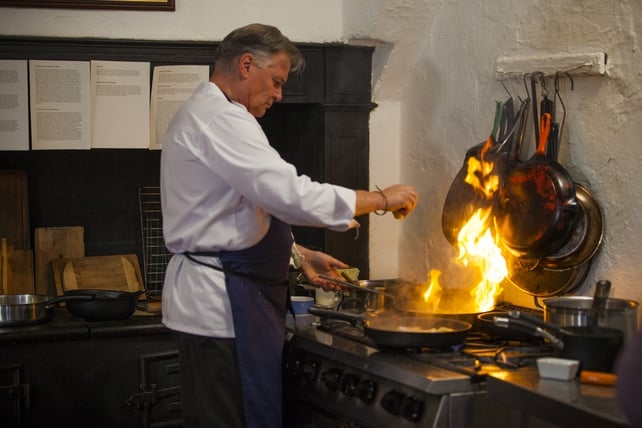
Entrée
Mutton Cutlets, Braized, à la Soubise
Trim a neck of mutton into as many cutlets as there are bones; the neck must then be cut up into thick cutlets, and placed on a dish without being further trimmed. Next cut 1lb of fat bacon into narrow strips, about the sixth of an inch square, and an inch and a half long, and with these the cutlets should be larded in the following manner: Take a middle-sized larding-pin, and run it half through the lean of the cutlet: then, place a strip of bacon in the open end, and draw the larding-pin through, leaving the bacon in the cutlet: repeat this, until the cutlet has been studded with eight strips of bacon and proceed in the same manner with the remainder.
Stew some of the trimmings over the bottom of a large stewpan, or fricandeau pan, and place the cutlets upon them in circular order, with the bone-end pointing to the centre; cover them with the remainder of the trimmings, and garnish with a couple of sliced carrots, a large onion, stuck with four cloves, a garnished faggot of parsley, and one head of celery; season with a dozen pepper-corns and a blade of mace, moisten with a glass of brandy, and sufficient fresh broth or stock to cover the whole; place a buttered paper on this, put on the lid and set the cutlets to braize very gently on a slow fire, or in the oven, for about one hour and a half; when they are become nearly tender enough, draw the pan off the fire, and allow them to get partially cold in their own liquor.
The cutlets must then be carefully taken out, one at a time, with a small slice or skimmer, and placed in rows on a large earthen dish: when the whole are thus removed, another dish must be placed upon these to press them slightly, in order to give them an even surface. As soon as they have become firm by getting quite cold, trim them neatly with a sharp knife, by paring off the surface of each cutlet (without waste) so as to show the bacon inserted in the lean; put them into a deep sautapan with some half glaze, made with the broth they have been braized in, which must be strained, divested of all the grease, clarified, and afterwards boiled down for the purpose. A quarter of an hour before sending to table, put the cutlets on a brisk fire to warm, allow them to boil quickly for five minutes, then roll the sautapan about carefully, so as to glaze them all over, and dish them up in a close circle; fill the centre with some purée of onions, pour the remainder of the half glaze round the base of the entrée, and serve.
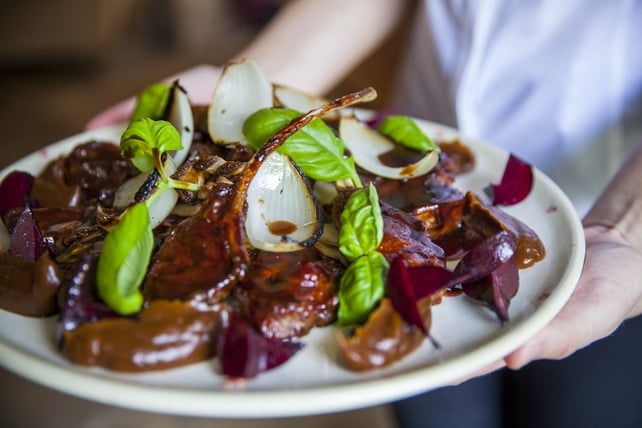
Purée of Onions à la Soubise
Peel and cut into slices eight large onions, parboil them in water for five minutes, drain them on a sieve, immerse them in cold water, and press them in a napkin to extract the water; place them in a stewpan with two ounces of butter, nutmeg, minionette pepper, a little salt, and a spoonful of white broth; put a round of buttered paper on them, and cover the stewpan with its lid; and set it on a very slow fire, to simmer gently for half an hour. Then turn the onions out into a deep sauta-pan, moisten with a small ladleful of good white sauce and half a pint of cream, reduce the purée quickly on a sharp fire, rub it through a tammy on to a dish, and take it up into a small stewpan. Just before using it, add a pinch of sugar.
Chicken with Truffles, à la Financiere
These must be cut up in the ordinary way, and after being neatly trimmed, should be placed in a sautapan with some clarified butter, seasoned with pepper and salt, and fried of a light-brown colour. When they are fried brown, pour off the grease; add a rich Financiére ragout, and half a pound of truffles cut into scallops or round balls; simmer the whole together on the fire for five minutes and then dish up into vol au vents, pour the ragout over it, garnish with crayfish and serve.
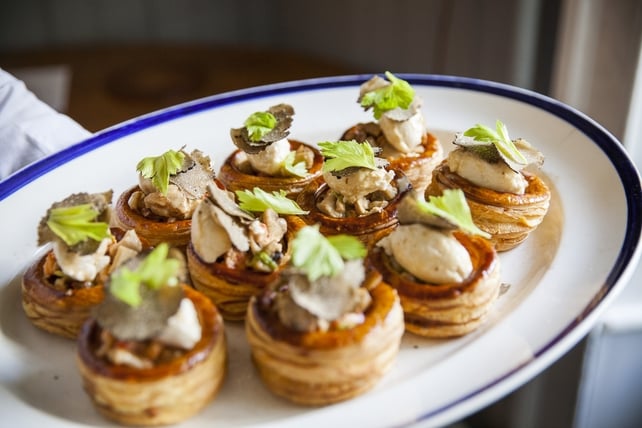
Financiere Ragout
Prepare some fine large white cocks’ combs and kernels, button mushrooms, small scallops of sweetbreads, and a proportionate quantity of truffles turned in the shape of scollops or olives and an equal portion of small quenelles, and add a small ladleful of well-finished Financiere sauce; allow the whole to boil slightly on the fire. Use this ragout for garnishing.
Financiere Sauce
Put one glass of sherry or madeira into a stewpan with some essence of truffles and a little cayenne; reduce these to half their original quantity, then add a ladleful of finished Espagnole sauce; let it boil for five minutes longer, and pass the sauce through a tammy into a bain-marie for use.
Releves
Braized Fillet of Beef, with Madeira Sauce
Lard a fillet of beef, prepare it for braising in the usual manner, moisten it with a bottle of good Madeira, and then set the fillet to braise gently on a slow fire; keep basting it frequently with its own liquor, and when done glaze it and place it on its dish. Garnish it round with a Macédoine; clarify the whole of the liquor in which the fillet has been braised, reduce it to the consistency of half glaze, and use it for the purpose of saucing the fillet and send to table.
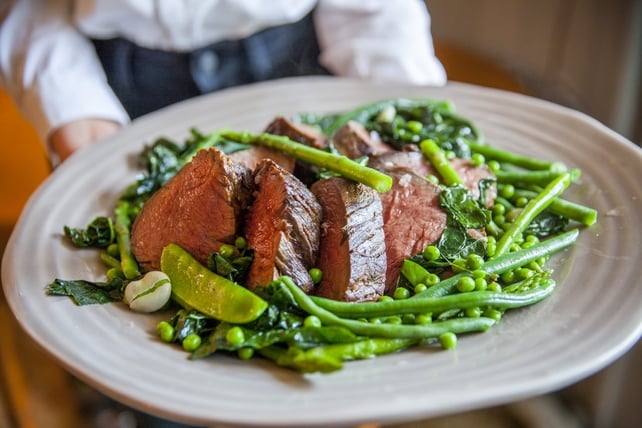
Brown Macedoine of Vegetables
Prepare some carrots and turnips in fancy shapes of small size, let each sort be separately broiled down to a glaze in a little broth, with the addition of a little sugar and salt, and a very small piece of butter; when done, put the whole together in a small sauta-pan; to these add a cucumber cut up and prepared for the purpose in scollops, a spoonful of boiled green peas, a spoonful of French beans cut in the shape of diamonds, a spoonful of asparagus heads boiled green, and also some very small flowrets of boiled cauliflower; add a gravy-spoonful of Espagnole sauce, a little nutmeg and sugar; shake the whole lightly together over the stove fire and use.
Boiled Turkey, with Oyster Sauce
Draw a fine young hen turkey and remove the angular part of the breast-bone, stuff it with veal stuffing and truss it for boiling; wrap some buttered paper round it, and place it in an oval braizing-pan with carrot, onion, one head of celery and a garnished faggot of parsley; add as much white poële or white stock, as will suffice to cover the turkey, then set it on a stove to boil; it should after that be removed to the side, or placed on a slackened stove to continue gently boiling till done; then take it up out of the braize, remove all the string etc. and set it to drain upon a napkin; dish it up, pour over it a some well-made oyster sauce.
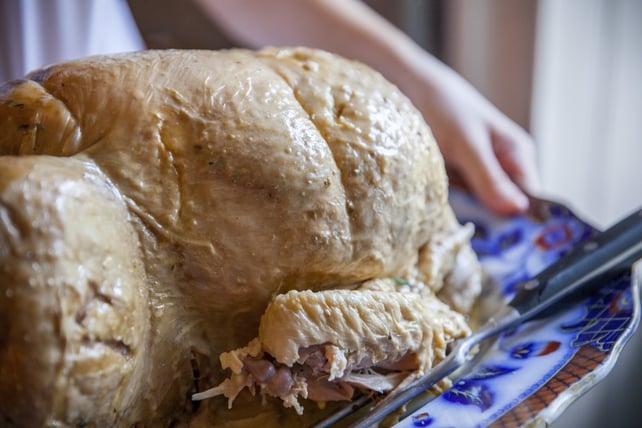
White Oyster Sauce
Put the oysters into a stewpan, and set them to boil for five minutes on the stove fire, drain them on a sieve (saving their liquor in a basin), wash and beard them, taking care to cut off the tendons, as that part when eaten is troublesome to the teeth, and put them into a bain-marie – reserving only the fat part; then put four ounces of butter (more or less according to the quantity of sauce) into a stewpan with two ounces of flour, cayenne pepper, and salt; knead these well together, and moisten with the oyster liquor, some cream, and a piece of glaze; stir the sauce on the fire, keeping it boiling for ten minutes; then pass through a tammy upon the oysters. Just before sending to table, add a little lemon juice.
White Poële for Poultry
Cut into dice-shaped pieces two pounds of beef suet, an equal quantity of veal, two heads of celery and the same number of onions and carrots; to these add the pulp of two lemons, removing the pips; put these ingredients into a middle-sized stewpan with half a pound of butter, and stir them on a slow fire until the suet is quite melted; then add three quarts of common broth, and keep the poële gently boiling for an hour; it should then be passed through a sieve into an earthen pan, and reserved for the purpose of braizing poultry in. Note – The two foregoing preparations, although very desirable in imparting a rich succulent flavour to poultry, game etc. are nevertheless to be regarded rather as luxurious than essential.
Gibier
Pheasants with Stewed Cabbages
These must be trussed as for boiling and placed in a rather large oval stewpan with three white-heart or Savoy cabbages previously cut into halves, the cores taken out, and blanched or parboiled; afterwards, the two halves of each cabbage, previously seasoned with mignionette pepper and salt, must be tied up with string; add two carrots, one head of celery, two onions, each stuck with two cloves, one pound of streaky bacon from which all the rust has been pared off, and which must also be parboiled like the cabbages, one pound of German sausage, and a garnished faggot of parsley; moisten with good stock in sufficient quantity to cover the pheasants, cover with a piece of buttered paper, put the lid on the stewpan, and then set the whole on a moderate fire to stew very gently for about two hours. Just before sending to table, take out the pheasants, drain them upon a napkin, remove the strings, and dish them up with an ornamental crôustado of fried bread in the centre; then put the bacon and German sausage upon a plate, and after having drained the cabbages in a colander, roll them in a clean napkin in the form of a rolling pin; cut this into two-inch lengths and place them round the pheasants, trim the bacon, cut it into strips and lay them on the top of the circle of the pieces of cabbages in alternate layers with slices of the sausage; about the upper part of this dish, place well-formed groups of nicely-shaped glazed carrots, turnips and onions, prepared for the purpose; pour an Espagnole sauce over the whole, glaze the pheasants and the roots, and serve.
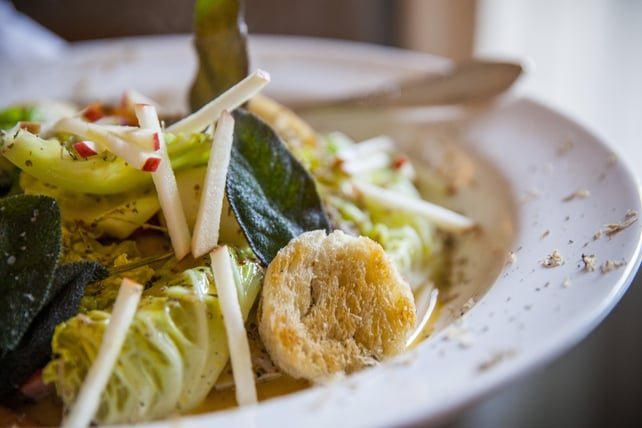
Civit of Hare with Mushrooms
Note: substitute rabbit
Cut the rabbit into small joints, then parboil one pound of streaky bacon, and cut it into square pieces the size of small walnuts; fry these in a stewpan until they acquire a light-brown colour, then take them out on a plate, and fry the pieces of rabbit brown also. Next, shake a handful of flour over them, and toss them over the fire for three minutes; add the fried bacon, a pottle of mushrooms, an onion stuck with four cloves, a carrot and a garnished faggot of parsley; season with pepper and salt, moisten with a pint of port wine, and a quart of good broth, stir the civet on the fire till it boils, and then remove it to the side that it may clarify itself by gentle ebullition. Fry half a pint of button onions in a small stewpan with a little butter, for five minutes, and when the civet has boiled about half an hour, throw these in; as soon as the pieces of rabbit become tender, remove the scum and grease from the surface, take out the onion, carrot and faggot; and if there appears to be too much sauce, pour it into another stewpan, and reduce it by boiling, stirring it with a wooden spoon to prevent its burning, then pass it through a tammy upon the civet. Pile up the pieces of hare in the centre of the dish, and garnish round with the mushrooms etc; pour the sauce over it, place a dozen croutons of fried bread cut in the shape of a heart round the base and serve.
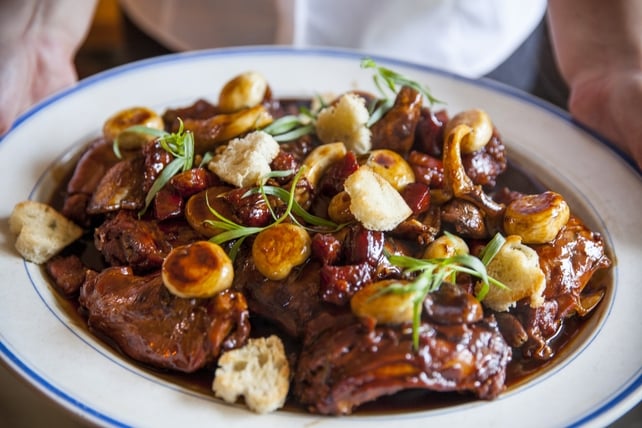
Entremets
Pudding à la Diplomate
Take 8 yolks of eggs, 4 oz. white sugar, ½ pint milk, 5 leaves gelatine. Put them on the fire taking care not to let them boil. Decorate a mould with some dried fruits. Then cut some Naples biscuits the length of the mould. Soak some raisins the night before in white wine, and put a row of cake and a row of raisins alternately. Then pour the mixture over it, and set on ice. Serve with a sauce as for blanc mange, adding white Curaçoa to it.
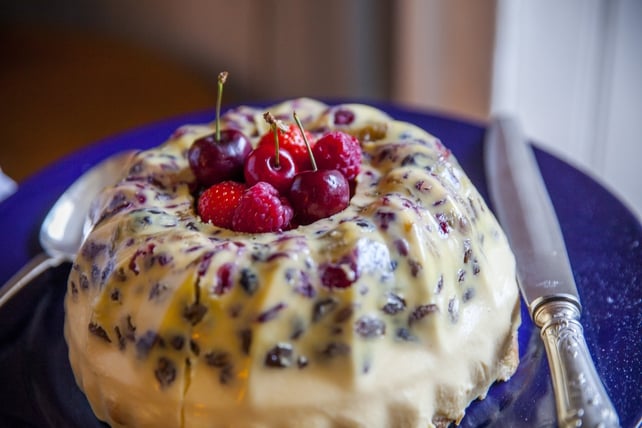
Sauce for Blanc Mange
Make a thin syrup with loaf sugar. Cut the peel of a lemon into very fine chips. When the sugar is boiling, squeeze in some lemon-juice, and when lukewarm throw in the chips. As soon as it is quite cold pour it over the custard before it is sent to table.
Meringues
Ingredients required: One pound of sifted sugar, and twelve whites of egg.
Whisk the whites in an egg-bowl until they present the appearance of a perfectly white, smooth, substantial froth, resembling snow; then substitute a spoon for the whisk and proceed to mix in the whole of the sugar, lightly; carefully avoid working the batter too much for fear of rendering it soft, as in that case it becomes difficult to mould the meringues; they can never be so gracefully shaped as when it is kept firm. Next, cut some stiff foolscap paper into bands about two inches wide; then take a tablespoon and gather it nearly full of the batter, by working it up at the side of the bowl in the form of an egg, and drop this slopingly upon one of the bands of paper, at the same time drawing the edge of the spoon shaply round the outer base of the meringue so as to give to it a smooth and rounded appearance, in order that it may exactly resemble an egg. Proceed in this manner until the band is full, keeping the meringues about two inches and a half apart from each other on the slab or table, and when all the batter is used up, shake some rather coarse sifted sugar all over them, and allow it to remain for about three minutes; then take hold of one of the bands at each end, shake off the loose sugar and place the band of meringues on the board, and so on with the other bands, which when placed carefully on the boards closely side by side must be put in the oven (at very moderate heat) and baked of a light-fawn colour. When done, each piece of meringue must be carefully removed from off the paper, the white part of the inside scooped out with a dessert spoon, and then nicely smoothed over; after this, they must be placed in neat order on a baking sheet and put back again in the oven to dry, taking particular care that they do not acquire any more colour.
When about to send the meringues to table, whip some double cream, season it with a little pounded sugar, and either a glass of any kind of liqueur, a few drops of orange-flower water, or some pounded vanilla; garnish each piece with a spoonful of this crema, join two together, dish them up in a pyramidal form on a napkin, and serve.
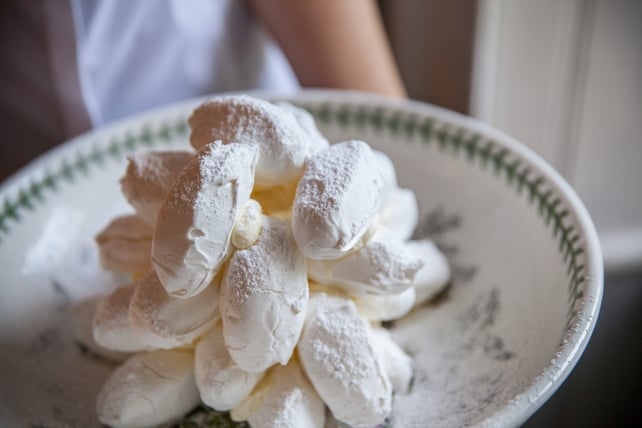
Curd Puffs
To the curd of two quarts of new milk well drained, add the yolks of seven eggs and the whites of two, sugar, rose-water, nutmeg and bread crumbs; make it into a paste, cut it into any shape you like, fry them in boiling lard, and serve them with a sauce made with butter, sugar and white wine.
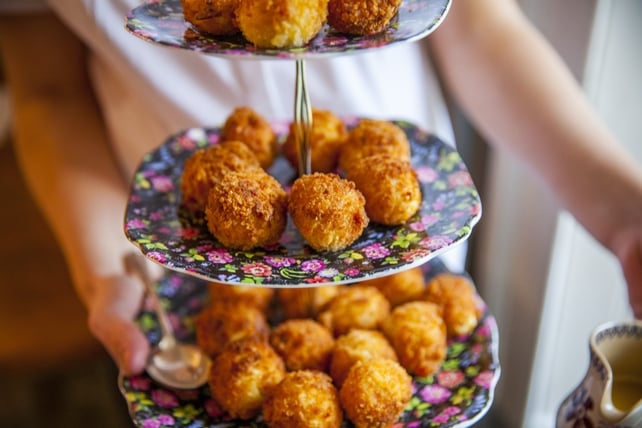
Glace
Pudding Glacée with Marmalade
Make a good custard with a stick of vanilla, brandy and white wine; if the custard is not quite smooth strain it, then add half a pint of cream, the juice of a lemon, and a good glass of jelly if you have it, or a little boiled isinglass. Put it into your pudding mould, then put into your mould in layers apricot jam, strawberry jam and currant jelly at different times but do not let it be seen on the outside of the pudding. After having put it through the freezing process as for your dessert ices, dish it on a napkin.
